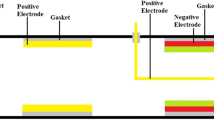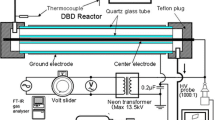Abstract
Recently, diesel engine exhaust emission control by non-thermal plasma (NTP) technology has been shown to be promising. However, carbon and soot deposition on the inner surface of the NTP reactor for direct plasma processing decreased the efficiency of the plasma process throughout the experiments. In the present work, the feasibility of indirect plasma processing was investigated as an innovative and novel method compared to direct plasma processing. Air was directed through an NTP at an applied voltage of VP-P = 7 kV and a flow rate of 1–4 L/min, and then, it was combined with engine exhaust gas at a flow rate of 5 L/min. In this case, the maximum conversion of NOX was 64.9% at 4 L/min. However, for direct plasma processing at 5 L/min, NO conversion was 58%, which proves that the indirect NTP process can decrease NOX concentration effectively. The maximum conversion for unburned hydrocarbon (UHC), carbon monoxide (CO) and carbon dioxide (CO2) was obtained as 2%, 4% and 0.7% at 4, 2 and 3 L/min in indirect plasma processing; While their remove rate for direct plasma processing was 16.3%, −0.5% and 13.2%, respectively.









Similar content being viewed by others
References
Air quality guidelines for Europe. 2nd ed. WHO Regional Publications, European Series, No. 91, 2000.
Miri M, Derakhshan Z, Allahabadi A, Ahmadi E, Conti GO, Ferrante M, Aval HE. Mortality and morbidity due to exposure to outdoor air pollution in Mashhad metropolis, Iran. AirQ Model Approach Environ Res. 2016;151:451–7.
Ahmadi E, Kakavandi B, Azari A, Izanloo H, Gharibi H, Mahvi AH, Javid A, Hashemi SY. The performance of mesoporous magnetite zeolite nanocomposite in removing dimethyl phthalate from aquatic environments. Desalin Water Treat. 2016;57:27768–82.
Ahmadi E, Yousefzadeh S, Mokammel A, Miri M, Ansari M, Arfaeinia H, Badi MY, Ghaffari HR, Rezaei S, Mahvi AH. Kinetic study and performance evaluation of an integrated two-phase fixed-film baffled bioreactor for bioenergy recovery from wastewater and bio-wasted sludge. Renew Sust Energ Rev. 2020;121:109674.
Dehghani MH, Salari M, Naddafi K, Nazmara S, Ahmadi E, Kumar P. Evaluation of formaldehyde concentration in the ambient air of a most populated Iranian city. Tehran Air Qual Atmos Health. 2017;10:763–72.
Yousefzadeh S, Ahmadi E, Gholami M, Ghaffari HR, Azari A, Ansari M, Miri M, Sharafi K, Rezaei S. A comparative study of anaerobic fixed film baffled reactor and up-flow anaerobic fixed film fixed bed reactor for biological removal of diethyl phthalate from wastewater: a performance, kinetic, biogas, and metabolic pathway study. Biotechnol Biofuels. 2017;10:139.
Gholizadeh A, Taghavi M, Moslem A, Neshat AA, Najafi ML, Alahabadi A, Ahmadi E, Asour AA, Rezaei H, Gholami S. Ecological and health risk assessment of exposure to atmospheric heavy metals. Ecotoxicol Environ Saf. 2019;184:109622.
Ghaffari HR, Aval HE, Alahabadi A, Mokammel A, Khamirchi R, Yousefzadeh S, Ahmadi E, Rahmani-Sani A, Estaji M, Ghanbarnejad A. Asthma disease as cause of admission to hospitals due to exposure to ambient oxidants in Mashhad. Iran Environ Sci Pollut Res. 2017;24:27402–8.
Prüss-Ustün A, Wolf J, Corvalán C, Bos R and Neira M. Preventing disease through healthy environments: a global assessment of the burden of disease from environmental risks. World Health Organization; (2016).
Babaie M, Davari P, Talebizadeh P, Zare F, Rahimzadeh H, Ristovski Z, Brown R. Performance evaluation of non-thermal plasma on particulate matter, ozone and CO2 correlation for diesel exhaust emission reduction. Chem Eng J. 2015;276:240–8.
Talebizadeh P, Babaie M, Brown R, Rahimzadeh H, Ristovski Z, Arai M. The role of non-thermal plasma technique in NOX treatment: a review. Renew Sust Energ Rev. 2014;40:886–901.
Tang X, Lu H, Lin L, Yao S. Experimental investigation of plasma oxidization of diesel particulate matter. Plasma Chem Plasma Process. 2013;33:281–92.
Madhukar A, Rajanikanth B. Augmenting NOX reduction in diesel exhaust by combined plasma/ozone injection technique, a laboratory investigation. The Institution of Engineering and Technology; 2017.
Brüggemann TC, Keil FJ. Theoretical investigation of the mechanism of the selective catalytic reduction of nitric oxide with ammonia on H-form zeoles. J Phys Chem C. 2008;112:17378–87.
Zhao G-B, Garikipati SVBJ, Hu X, Argyle MD, Radosz M. Effect of oxygen on nonthermal plasma reactions of nitrogen oxides in nitrogen. Am Inst Chem Eng. 2005;51(6):1800.
Skalska K, Miller JS, Ledakowicz S. Trends in NOX abatement: a review. Sci Total Environ. 2010;408:3976–89.
Mok YS, Lee H-J. Removal of sulfur dioxide and nitrogen oxides by using ozone injection and absorption–reduction technique. Fuel Process Technol. 2006;87:591–7.
Van Durme J, Dewulf J, Leys C, Van Langenhove H. Combining non-thermal plasma with heterogeneous catalysis in waste gas treatment: a review. Appl Catal B Environ. 2008;78:324–33.
Mok YS, Koh DJ, Kim KT, Nam I-S. Nonthermal plasma-enhanced catalytic removal of nitrogen oxides over V2O5/TiO2 and Cr2O3/TiO2. Ind Eng Chem Res. 2003;42:2960–7.
Jõgi I, Erme K, Levoll E, Raud J, Stamate E. Plasma and catalyst for the oxidation of NOX. Plasma Sources Sci Technol. 2018;27:035001.
Hosseini Rad R, Khani M, Mehdi Kia H, Shafiei M, Shokri B. Decomposition of high concentration benzene (produced in paper and painting industries) and its byproducts, methane and carbon dioxide, using plate gliding arc. J Environ Health Sci Eng. 2019;17:549–60.
Rajanikanth B, Rout S. Studies on nitric oxide removal in simulated gas compositions under plasma-dielectric/catalytic discharges. Fuel Process Technol. 2001;74:177–95.
Hołub M, Kalisiak S, Borkowski T, Myśków J, Brandenburg R. The influence of direct non-thermal plasma treatment on particulate matter (PM) and NOX in the exhaust of marine diesel engines. Pol J Environ Stud. 2010;19:1199–211.
Yao S, Shen X, Zhang X, Han J, Wu Z, Tang X, Lu H, Jiang B. Sustainable removal of particulate matter from diesel engine exhaust at low temperature using a plasma-catalytic method. Chem Eng J. 2017;327:343–50.
Shi Y, Cai Y, Li X, Xu H, Li W, Pu X. Low temperature diesel particulate filter regeneration by atmospheric air non-thermal plasma injection system. Plasma Chem Plasma Process. 2016;36:783–97.
Yousefzadeh S, Matin AR, Ahmadi E, Sabeti Z, Alimohammadi M, Aslani H, Nabizadeh R. Response surface methodology as a tool for modeling and optimization of bacillus subtilis spores inactivation by UV/ nano-Fe0 process for safe water production. Food Chem Toxicol. 2018;114:334–45.
Linbo G, Yixi C, Yunxi S, Jing W, Xiaoyu P, Jing T, Runlin F. Effect of indirect non-thermal plasma on particle size distribution and composition of diesel engine particles. Plasma Sci Technol. 2017;19:115503.
Matin AR, Yousefzadeh S, Ahmadi E, Mahvi A, Alimohammadi M, Aslani H, Nabizadeh R. A comparative study of the disinfection efficacy of H2O2/ferrate and UV/H2O2/ferrate processes on inactivation of Bacillus subtilis spores by response surface methodology for modeling and optimization. Food Chem Toxicol. 2018;116:129–37.
Gao J, Ma C, Xia F, Xing S, Sun L, Huang L. Raman characteristics of PM emitted by a diesel engine equipped with a NTP reactor. Fuel. 2016;185:289–97.
Badi M, Azari A, Esrafili A, Ahmadi E, Gholami M. Performance evaluation of magnetized multiwall carbon nanotubes by iron oxide nanoparticles in removing fluoride from aqueous solution. J Mazandaran Univ Med Sci. 2015;25:128–42.
Hammer T, Kappes T, Baldauf M. Plasma catalytic hybrid processes: gas discharge initiation and plasma activation of catalytic processes. Catal Today. 2004;89:5–14.
Hueso J, Cotrino J, Caballero A, Espinós J, González-Elipe A. Plasma catalysis with perovskite-type catalysts for the removal of NO and CH4 from combustion exhausts. J Catal. 2007;247:288–97.
Penetrante B, Brusasco R, Merritt B, Pitz W, Vogtlin G. Plasma-assisted catalytic reduction of NOx. Warrendale: Sae International; 1998.
Jogi I, Stamate E, Irimiea C, Schmidt M, Brandenburg R, Hołub M, Bonisławski M, Jakubowski T, Kääriäinen M-L, Cameron DC. Comparison of direct and indirect plasma oxidation of NO combined with oxidation by catalyst. Fuel. 2015;144:137–44.
Holub M. On the measurement of plasma power in atmospheric pressure DBD plasma reactors. Int J Appl Electromagn Mech. 2012;33:307–322.
Wang T, Sun B-M, Xiao H-P. Characteristics and analysis of the mechanism of NO removal in dielectric barrier discharge plasma by hydrocarbons at varying temperatures. Plasma Chem Plasma Process. 2013;33:307–22.
Pârvulescu VI, Magureanu M, Lukes P. Plasma chemistry and catalysis in gases and liquids. Wiley; 2012.
National Institute of Standards and Technology. NIST Chemical Kinetics Database. http://kinetics.nist.gov/kinetics/index.jsp
Obradović BM, Sretenović GB, Kuraica MM. A dual-use of DBD plasma for simultaneous NOX and SO2 removal from coal-combustion flue gas. J Hazard Mater. 2011;185:1280–6.
Arai M, Saito M, Yoshinaga S. Effect of oxygen on NOX removal in corona discharge field: NOX behavior without a reducing agent. Combust Sci Technol. 2004;176:1653–65.
Penetrante BM, Schultheis SE. Non-thermal plasma techniques for pollution control: part b: electron beam and electrical discharge processing. Springer Science & Business Media; 2013.
Atkinson R, Baulch D, Cox R, Hampson R Jr, Kerr J, Troe J. Evaluated kinetic and photochemical data for atmospheric chemistry: supplement IV. IUPAC subcommittee on gas kinetic data evaluation for atmospheric chemistry. J Phys Chem Ref Data. 1992;21:1125–568.
McLarnon CR, Penetrante BM. Effect of gas composition on the NOx conversion chemistry in a plasma. San Francisco: Society of Automotive Engineers Fall Fuels and Lubricants Meeting; 1998.
Jõgi I, Erme K, Raud J, Laan M. Oxidation of NO by ozone in the presence of TiO2 catalyst. Fuel. 2016;173:45–54.
Hammer T. Non-thermal plasma application to the abatement of noxious emissions in automotive exhaust gases. Plasma Sources Sci Technol. 2002;11:A196–201.
Mok YS, Lee H-J, Dors M, Mizeraczyk J. Improvement in selective catalytic reduction of nitrogen oxides by using dielectric barrier discharge. Chem Eng J. 2005;110:79–85.
Babaie M. Reduction of diesel engine exhaust emissions using non-thermal plasma technology. PhD Thesis. Queensland University of Technology; 2015.
Thomas SE, Martin AR, Raybone D, Shawcross J.T, Ng KL, Beech P, Whitehead JC. Non thermal plasma aftertreatment of particulates-theoretical limits and impact on reactor design. SAE Technical Paper; 2000.
Tang X, Lu H, Lin L, Yao S. Experimental investigation of plasma oxidization of diesel particulate matter. Plasma Chem Plasma Process. 2013;33:281–92.
Okubo M, Yamada H, Yoshida K and Kuroki T. Simultaneous reduction of diesel particulate and NOX using a catalysis-combined nonthermal plasma reactor. Ieee Transactions on Industry Applications. 2017;53(6):5875–5882.
Grundmann J, Muller S, and Zahn R-J. Treatment of soot by dielectric barrier discharges and ozone. Plasma Chem Plasma Process. 2005;25(5):5875–5882.
Jo J-O, Trinh HQ, Kim SH, Mok YS. Simultaneous removal of hydrocarbon and CO using a nonthermal plasma-catalytic hybrid reactor system. Chem Eng J. 2016;299:93–103.
Author information
Authors and Affiliations
Corresponding author
Ethics declarations
Conflict of interest
There is no conflict of interest.
Additional information
Publisher’s note
Springer Nature remains neutral with regard to jurisdictional claims in published maps and institutional affiliations.
Rights and permissions
About this article
Cite this article
Khani, M.R., Barzideh Pour, E., Rashnoo, S. et al. Real diesel engine exhaust emission control: indirect non-thermal plasma and comparison to direct plasma for NOX, THC, CO, and CO2. J Environ Health Sci Engineer 18, 743–754 (2020). https://doi.org/10.1007/s40201-020-00500-0
Received:
Accepted:
Published:
Issue Date:
DOI: https://doi.org/10.1007/s40201-020-00500-0




